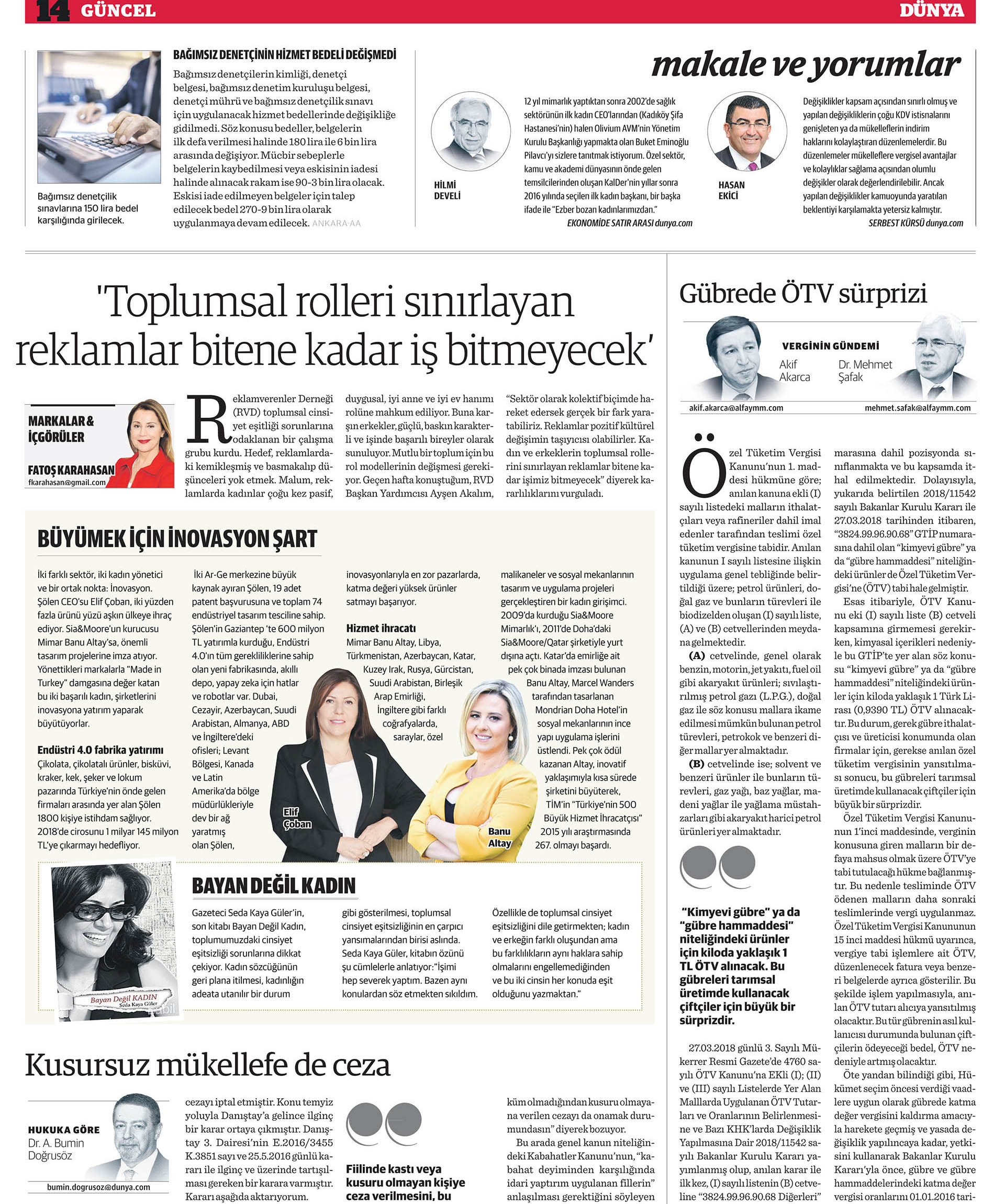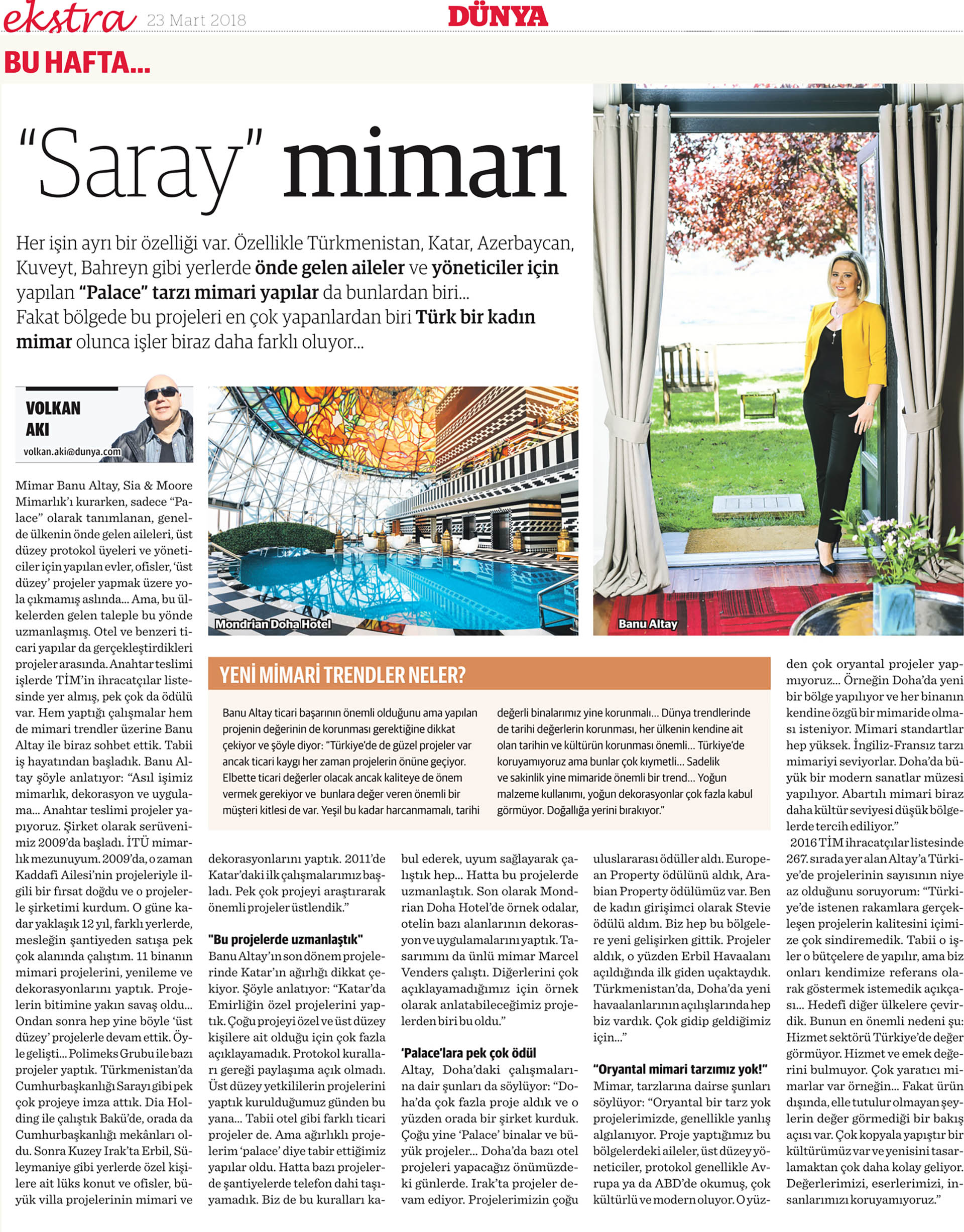
INNOVATION IS ESSENTIAL FOR GROWTH
İki farklı sektör, iki kadın yönetici ve bir ortak nokta: İnovasyon. Şölen CEO’su Elif Çoban, iki yüzden fazla ürünü yüzü aşkın ülkeye ihraç ediyor. Sia Moore’un kurucusu Mimar Banu Altay’sa, önemli tasarım projelerine imza atıyor. Yönettikleri markalarla “Made in Turkey” damgasına değer katan bu iki başarılı kadın, şirketlerini inovasyona yatırım yaparak büyütüyorlar.
Factory investments for Industry 4.0
Şölen, a prominent brand in Turkish chocolate, chocolate products, biscuit, cracker, cake, candy and Turkish delight market, employs 1800 people. Their revenue goal for 2018 is 1 billion 145 million Turkish liras.
Şölen has allocated significant resources to its two R&D centers, and currently hold 19 patent applications and 74 industrial design registrations. The new factory they set up in Gaziantep with an initial investment of 600 million Liras is fully compatible with Industry 4.0 and own a smart warehouse, and lines and robots for artificial intelligence. Şölen has created a giant network with its offices in Dubai, Algeria, Azerbaijan, Saudi Arabia, Germany, USA and England, and regional headquarters in Levant, Canada and South America, and the company’s innovations help them sell high value-added products in toughest markets.
Service exports
Mimar Banu Altay, Libya, Türkmenistan, Azerbaycan, Katar, Kuzey Irak, Rusya, Gürcistan, Suudi Arabistan, Birleşik Arap Emirliği, İngiltere gibi farklı coğrafyalarda, saraylar, özel malikaneler ve sosyal mekanlarının tasarım ve uygulama projeleri gerçekleştiren bir kadın girişimci. 2009’da kurduğu Sia Moore Mimarlık’ı, 2011’de Doha’daki Sia Moore/Qatar şirketiyle yurt dışına açtı. Katar’da emirliğe ait pek çok binada imzası bulunan Banu Altay, Marcel Wanders tarafından tasarlanan Mondrian Doha Hotel’in sosyal mekanlarının ince yapı uygulama işlerini üstlendi. Pek çok ödül kazanan Altay, inovatif yaklaşımıyla kısa sürede şirketini büyüterek, TİM’in “Türkiye’nin 500 Büyük Hizmet İhracatçısı” 2015 yılı araştırmasında 267. olmayı başardı.
Fatoş Karahasan
MARKALAR & İÇGÖRÜLER

THE “PALACE” ARCHITECT
Every job has a distinctive feature. The palace-style architecture that prominent families and executives request in countries like Turkmenistan, Qatar, Azerbaijan, Kuwait and Bahrain is no exception. Yet it becomes especially distinctive when one of the most demanded architects for these buildings is a Turkish woman…
Mimar Banu Altay, Sia Moore Mimarlık’ı kurarken, sadece “Palace” olarak tanımlanan, genelde ülkenin önde gelen aileleri, üst düzey protokol üyeleri ve yöneticiler için yapılan evler, ofisler, ‘üst düzey’ projeler yapmak üzere yola çıkmamış aslında… Ama, bu ülkelerden gelen taleple bu yönde uzmanlaşmış. Otel ve benzeri ticari yapılar da gerçekleştirdikleri projeler arasında. Anahtar teslimi işlerde TİM’in ihracatçılar listesinde yer almış, pek çok da ödülü var. Hem yaptığı çalışmalar hem de mimari trendler üzerine Banu Altay ile biraz sohbet ettik. Tabii iş hayatından başladık. Banu Altay şöyle anlatıyor: “Asıl işimiz mimarlık, dekorasyon ve uygulama… Anahtar teslimi projeler yapıyoruz. Şirket olarak serüvenimiz 2009’da başladı. İTÜ mimarlık mezunuyum. 2009’da, o zaman Kaddafi Ailesi’nin projeleriyle ilgili bir fırsat doğdu ve o projelerle şirketimi kurdum. O güne kadar yaklaşık 12 yıl, farklı yerlerde, mesleğin şantiyeden satışa pek çok alanında çalıştım. 11 binanın mimari projelerini, yenileme ve dekorasyonlarını yaptık. Projelerin bitimine yakın savaş oldu… Ondan sonra hep yine böyle ‘üst düzey’ projelerle devam ettik. Öyle gelişti… Polimeks Grubu ile bazı projeler yaptık. Türkmenistan’da Cumhurbaşkanlığı Sarayı gibi pek çok projeye imza attık. Dia Holding ile çalıştık Bakü’de, orada da Cumhurbaşkanlığı mekânları oldu. Sonra Kuzey Irak’ta Erbil, Süleymaniye gibi yerlerde özel kişilere ait lüks konut ve ofisler, büyük villa projelerinin mimari ve dekorasyonlarını yaptık. 2011’de Katar’daki ilk çalışmalarımız başladı. Pek çok projeyi araştırarak önemli projeler üstlendik.”
“We’ve specialized in these projects”
Altay’s latest projects heavily involve Qatar. She explains:
“We designed the Emirates special projects in Qatar. We couldn’t go public with many of these because they involved private and high-level people. Signed protocols didn’t allow us to do so. We have undertaken projects for high-level state officials since day one… Of course we’ve had a couple of commercial projects like hotels. But mostly they were structures that we call ‘palaces’. We were not even allowed to have cellphones in construction yards for some of those projects.
Many awards for “Palace”s
Altay states the following on her work in Doha: “We undertook too many projects in Doha, so we had to found a company there. Most of them were yet again ‘Palace’ buildings and big projects… We have a few hotel projects coming up. Our projects in Iraq are also under way. Many of our projects won international awards, among which are European Property award, Arabian Property award… I’ve won a Stevie award as a woman entrepreneur. We were working in these regions while they were newly developing. We signed onto projects so early that we were aboard the first plane that landed in Erbil Airport. We were in Turkmenistan, in Doha when new airports opened there. We have traveled so frequently...”
“We don’t have an oriental architectural style!”
This is what Altay says about their style: “We don’t have an oriental style in our projects, that’s one of the common misconceptions. The families, top-level executives, officials in those regions are usually European or American-educated, cultured and modern people. For that reason, our projects are mostly non-oriental. For example, they are developing a new region in Doha, and they want every single building to have its unique architecture. They hold people to high architectural standards. They enjoy British-French influences in architecture. They are also building a large Museum of Modern Arts in Doha. An exaggerated style is more common in regions that are culturally underdeveloped.”
Altay is ranked 267th in the 2016 Top Exporters list by TEA, but she has only undertaken a few projects in Turkey. I asked her why: “We were not satisfied with the quality of the works in relation to their price tags. Of course it is possible to finish those projects with those budgets, but frankly, we didn’t want to have them listed among our references… That’s why we started looking at other countries. The main reason is this: Service industry is undervalued in Turkey. The compensation for service and labor is nowhere near their true worth. We have very creative architects in this country… But the prevalent point of view doesn’t appreciate these intangible qualities, only the end product. We have an accepted copy-paste culture, and that is much easier than a design from scratch. We cannot protect our values, our works, our people.”
WHAT ARE THE NEW ARCHITECTURAL TRENDS?
According to Altay, commercial success is important yet the value of the projects must also be protected. She says: “Of course there are beautiful projects in Turkey, but commercial concerns always take precedence. Commercial value will naturally be a part of the calculation, but it is necessary to pay attention to quality of work as well, and there is indeed a significant clientele who cares about that. Greens shouldn’t be wasted away so easily, our buildings of historical value should be preserved… Preservation of historical values, that each country should preserve its history and culture is indeed a global trend… We don’t do that in Turkey, but they are so valuable… Another important architectural trend is simplicity and serenity… Intensive use of materials, intensive decorations are not widely accepted. That is being replaced by naturalness.”
Volkan Akı
